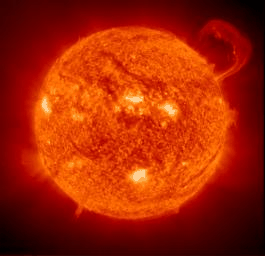PRIMARY COSMIC RAYS


PRIMARY COSMIC RAYS
The solar wind decelerates the incoming particles and blocks some of the particles with energies below about 1 GeV. The amount of solar wind is not constant due to changes in solar activity. Thus, the level of the cosmic ray flux varies with solar activity. The Earth's magnetic field deflects some of the cosmic rays, giving rise to the observation that the flux is apparently dependent on latitude, longitude, and azimuth angle. The magnetic field lines deflect the cosmic rays towards the poles, giving rise to the aurora.


PRIMARY COSMIC RAYS
Primary cosmic rays originate mainly outside the Solar system, i. e. in the Galaxy or even in other galaxies. When they interact with Earth's atmosphere, they are converted to secondary particles. The mass ratio of hydrogen to helium nuclei (28%) is about the same as the primordial elemental abundance ratio of these elements (24%).
The remaining fraction is made up of the other heavier nuclei that are nuclear synthesis end products, products of the Big Bang[citation needed], primarily lithium, beryllium, and boron. These light nuclei appear in cosmic rays in much greater abundance (~1%) than in the solar atmosphere, where their abundance is about 10−9% that of helium.
This abundance difference is a result of the way secondary cosmic rays are formed. Carbon and oxygen nuclei collide with interstellar matter to form lithium, beryllium and boron in a process termed cosmic ray spallation. Spallation is also responsible for the abundances of scandium, titanium, vanadium, and manganese ions in cosmic rays produced by collisions of iron and nickel nuclei with interstellar matter. See Natural Environmental Radioactivity.
Satellite experiments have found evidence of a few antiprotons and positrons in primary cosmic rays, although there is no evidence of complex antimatter atomic nuclei, such as anti-helium nuclei (anti-alpha) particles. Antiprotons arrive at Earth with a characteristic energy maximum of 2 GeV, indicating their production in a fundamentally different process from cosmic ray protons.
[edit]Flux of Primary Cosmic Rays
The solar wind decelerates the incoming particles and blocks some of the particles with energies below about 1 GeV. The amount of solar wind is not constant due to changes in solar activity. Thus, the level of the cosmic ray flux varies with solar activity. The Earth's magnetic field deflects some of the cosmic rays, giving rise to the observation that the flux is apparently dependent on latitude, longitude, and azimuth angle. The magnetic field lines deflect the cosmic rays towards the poles, giving rise to the aurora.
The flux of incoming cosmic rays at the upper atmosphere is dependent on the solar wind, the Earth's magnetic field, and the energy of the cosmic rays.
At distances of ~94 AU from the Sun, the solar wind undergoes a transition, called the termination shock, from supersonic to subsonic speeds. The region between the termination shock and the heliopause acts as a barrier to cosmic rays, decreasing the flux at lower energies by about 90%.
In the past, it was believed that the cosmic ray flux remained fairly constant over time. However, recent research suggests 1.5 to 2-fold millennium-timescale changes in the cosmic ray flux in the past forty thousand years.
The magnitude of the energy of cosmic ray flux in interstellar space is very comparable to that of other deep space energies: cosmic ray energy density averages about one electron-volt per cubic centimeter of interstellar space, or ~1 eV/cm3, which is comparable to the energy density of visible starlight at 0.3 eV/cm3, the galactic magnetic field energy density (assumed 3 microgauss) which is ~0.25 eV/cm3, or the cosmic microwave background (CMB) radiation energy density at ~ 0.25 eV/cm3.
However, cosmic rays, unlike the other energy components above, are composed of ionizing particles, and this is far more damaging to biological processes than simple energies suggest. As noted below, cosmic rays make up on average 10 to 15% of background ionizing radiation to humans on Earth, but this component can be several times larger for persons living at higher altitudes.
The number of particles that hit the ground is dependent on several factors including location with respect to the earth's magnetic field, solar cycle, elevation, and the energy of the particles. For 1 GeV particles, the rate of arrival is about 10,000 per square meter per second. At 1 TeV the rate is 1 particle per square meter per second. At 10 PeV there are only a few particles per square meter per year. Particles above 10 EeV arrive only at a rate of about one particle per square kilometer per year, and above 100 EeV at a rate of about one particle per square kilometer per century.
PLEASE GIVE COMMENT.
PLEASE GIVE COMMENT.
No comments:
Post a Comment